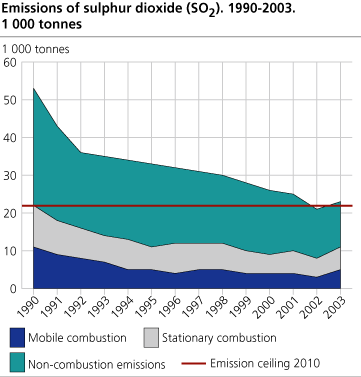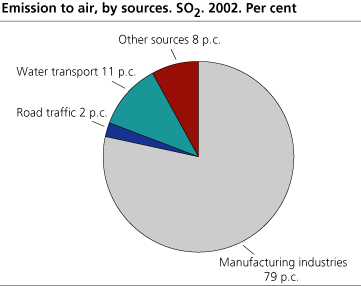Content
Published:
This is an archived release.
Increase in sulphur emissions
After almost 20 years of continuous decrease, the SO2 emissions rose by 3 per cent from 2002 to 2003. The growth was caused by increased sale of fuel for domestic shipping, and a change to fuel types with higher content of sulphur. Furthermore, the sulphur content of the fuel types used in shipping increased in 2003.
In Gothenburg in 1999, Norway signed a protocol on the reduction of long-range transboundary emissions in Europe. In this protocol, Norway has committed itself to reducing emissions of sulphur dioxide (SO2) to 22 000 tonnes, or about 58 per cent from the 1990 level by 2010.
Up 3 per cent
Every year since 1986 there has been a decline in the emissions of SO2. In 2003, however, the emissions rose to 22 800 tonnes, which was a growth of 700 tonnes, or 3 per cent, compared with the previous year. This is shown in the preliminary emission figures calculated by Statistics Norway in collaboration with the Norwegian Pollution Control Authority. Despite this growth, the emissions only have to be reduced by 800 tonnes by 2010 in order to reach the target in the Gothenburg protocol. In 2001, the Ministry of the Environment entered into an agreement with the Federation of Norwegian Process Industries to reduce the emissions of SO2 from industrial processes by 2010. It is expected that this agreement together with lower sulphur content in petrol and diesel will be among the measures that will make Norway able to meet the obligation in the Gothenburg Protocol.
|
Emission ceiling 2010 according to the Gothenburg Protocol. Status 2003.
Tonnes (per cent) |
| Component | Emissions 1990 | Emissions 2003 | Emission ceiling 2010 | Necessary reduction 2003-2010 | |||||||||||||||||||||||||||||||||||
|---|---|---|---|---|---|---|---|---|---|---|---|---|---|---|---|---|---|---|---|---|---|---|---|---|---|---|---|---|---|---|---|---|---|---|---|---|---|---|---|
| Sulphur dioxide (SO2) | 52 295 | 22 795 | 22 000 | 795 tonnes (3 per cent) | |||||||||||||||||||||||||||||||||||
Domestic shipping and heating with oil
In 2003, there was a switchover to more use of heavy oil and less use of special distillates in domestic shipping. Although the heavy oil was of a type with low sulphur content, it contains about three times as much sulphur as special distillates and, as a consequence, resulted in larger emissions. Further, the increase in sales of marine gas oil, and higher sulphur content also contributed to considerably higher emissions of SO2. There was a 25 per cent rise in the sulphur content of marine gas oil from 2002 to 2003. The sulphur content also rose for heavy oils and auto diesel. This led to a rise in emissions from mobile combustion by about 1 400 tonnes.
In all, the emissions from stationary combustion (for example heating of buildings) increased by almost 200 tonnes. The rise was due to higher electricity prices that resulted in heating with oil instead of electricity. However, the increase was lower than indicated by the growth in the sales of heating oil products, because the sulphur content of these oil types was lower than the previous year.
The growth subdued by other effects
The sulphur content of light fuel oil was reduced by a third from 2002 to 2003. Because of this, the SO2 emissions did not increase, despite the fact that there was an increase in the sales of heating oil products to private households. The sulphur content of petrol was halved from 2002. This means that the petroleum companies have started the adjustments to meet the new requirements coming into force from 2005. The sulphur content of petrol shall be further reduced from 2003 level of 0,005 per cent to 0,001 per cent by 2005. The process emissions from manufacturing industries decreased by 900 tonnes, mainly as a result of reduced activity.
Manufacturing industries have the highest emissions
The distribution of the emissions by industry is very uncertain in these preliminary 2003 calculations and will not be presented in detail here. In 2002, however, mining and manufacturing accounted for 80 per cent of the SO2 emissions. 60 per cent originated from different industrial processes, for instance from the manufacture of ferro-alloys and aluminium, while 18 per cent was generated by industrial combustion. Domestic shipping and fishing contributed to 11 per cent, and heating of housing and road traffic emitted 3 and 2 per cent respectively. The rest of the SO2 emissions, 5 per cent, came from air traffic, oil and gas extraction and other industries.
Emissions from international air and sea traffic are not included in the Gothenburg Protocol.
Decrease 1990-2002
Emissions of SO2 are different from for instance CO2 emissions because SO2 emissions can be reduced by technical measures. Through many years, the SO2 emissions in Norway have dropped as a result of installation of equipment to control emissions at a number of industrial plants (end-of-pipe solutions). A changeover from fossil fuel to electricity, use of lighter oil products, lower sulphur content of oil products and reducing agents are other measures that have contributed to the decrease in SO2 emissions. The Government's extra tax on auto diesel with more than 0,005 per cent sulphur has also given results, since the petroleum companies reduced the sulphur content of auto diesel shortly after the tax was introduced in January 2000. In the period 1990-2002, the SO2 emissions dropped by 58 per cent. But in 2003, the emissions showed an increase.
Uncertainty
There is a high degree of uncertainty connected to these preliminary calculations, and detailed figures distributed by industry and source will not be published until February 2005. The distribution of use of heavy oil between on-shore activities and use in ships is very uncertain, and so is the distribution between domestic shipping and international sea transport based on the sales statistics. This leads to uncertainty in the emission figures. Only emissions from domestic shipping are included in the Gothenburg Protocol.
Earlier this year, Statistics Norway and the Norwegian Pollution Control Authority published figures for the other gases covered by the Gothenburg Protocol. Read more here .
Tables
Table 1 Emissions to air, by source. 1990
Table 2 Emissions to air, by source. 2001
Table 3 Emissions to air, by source. 2002
More tables in StatBank .
Other articles on air pollution and greenhouse gases
Emissions of greenhouse gases.1990-2003
Emissions of NOX and NMVOC. 1990-2003
The statistics is published with Emissions to air.
Contact
-
Statistics Norway's Information Centre
E-mail: informasjon@ssb.no
tel.: (+47) 21 09 46 42


